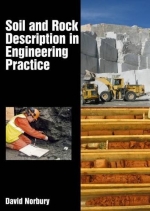Tab Article
In ground investigation, the description of soils and rocks in engineering practice forms a major input to the field log. The log records the materials and strata seen in any sample, core or exposure and is a basic element of the factual information that underpins the entire understanding and interpretation of the ground conditions on site. The field log is also all that remains after the investigation is over and so has a life well beyond that of the investigation report. Practical guidance is provided for those in the field carrying out engineering geological logging of soil and rock samples and exposures. Information on the current systematic and codified approach and its use are laid out in detail to ensure the defined descriptors are used in a consistent format, rendering mistakes less likely and the necessary communication from field to design more successful.
The procedures, techniques and tips within this book are not only for young practitioners learning their craft, but are also relevant for their seniors and mentors, including responsible experts who sign off the logs and report on behalf of their company. Although they may have been involved in logging for many years they need to be aware of current practices in order to avoid costly mistakes.
Soil and Rock Description in Engineering Practice enables the practitioner to record and present features of the ground from the exposure in such a way as to convey a field presence to subsequent users of the data. This is important as the samples deteriorate quickly and are not usually inspected by any party other than the logger. Field logs therefore provide the only record of the ground that is available to the designer and contractor later in the construction process.
The procedures given are in accordance with the newly-implemented ISO, EN and BS international standards and other practice such as ASTM is also considered. The rules set out in these standards are considerably amplified by the author's 35 years experience describing natural and anthropogenic materials in the field and in teaching others to do so.


